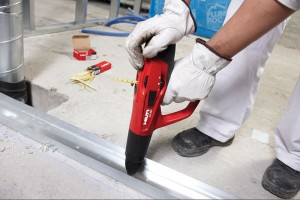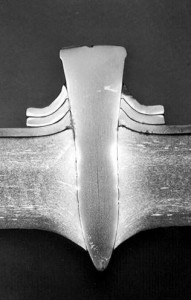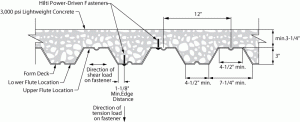Historical use of Power-Actuated Fasteners (PAFs)
Power-actuated fasteners, also called power-driven fasteners, DX/GX fastening systems or shot pins, have been used for decades and are routinely used on today’s construction projects in a wide variety of applications.
These types of fasteners are typically proprietary systems manufactured from hardened, ductile steel wire with small, but very significant features including full-tip knurling, special fastener point geometry and pre-mounted washers. Driven by powder cartridges, compressed gas or air, power-actuated fasteners offer an efficient, reliable and safe method for attaching many building materials to steel, concrete or masonry. Power-actuated tools are available as single shot, semi-automatic and automatic magazine tools, which can increase productivity.
Power-actuated fasteners are used in lateral force resisting structural systems such as untopped and concrete filled steel deck, and wood structural panel diaphragms and shear walls. In these applications, multiple power-actuated fasteners installed at specified patterns and spacings provide the strength and stiffness to the given structural system. Structural behavior and performance with power-actuated fasteners is well known and established based on small scale and large scale assembly tests.
Nonstructural systems are separate from structural systems, and a clear distinction is made in the building codes and standards. Nonstructural applications may involve suspended ceilings, conduit attachments, mechanical, plumbing, electrical and communications equipment, cold-formed steel track attachments and architectural components, and other applications that are not part of the structural systems. Nonstructural distributed systems are also frequently attached with power-actuated fasteners in redundant grid like arrangements or linear patterns. These applications are also important to performance of the overall structure; however, they generally don’t get as much attention or focus by the design team. Recent updates to building code provisions and ongoing university research are helping the industry and structural engineers understand more about power-actuated fasteners in nonstructural applications going forward.
Clarifying the Seismic Grey Zone
At the request of practicing structural engineers and Hilti, Inc., International Code Council Evaluation Services (ICC-ES) recently updated their Acceptance Criteria (AC) 70 for Fasteners Power – Driven into Concrete Steel and Masonry Elements. A key part of this update includes product evaluations to International Building Code (IBC) 2012 including the ASCE 7-10 Minimum Design Loads for Buildings and Other Structures reference standard. ASCE 7-10 Section 13.4.5 includes some new exception language pertaining to nonstructural component attachments in higher Seismic Design Categories D, E and F. This clarification helps establish certain nonstructural component fastening applications where power-actuated fasteners are deemed acceptable. Over the years, some confusion seemed to develop relative to power-actuated fasteners versus new concrete anchorage design requirements, but the ASCE 7 clarifying language now serves as a placeholder until more comprehensive seismic qualification test procedures for power-actuated fasteners are developed and implemented.
The ASCE 7-10 Section 13.4.5 exception addresses the use of power-actuated fasteners in applications that do not involve sustained tension loading or bracing. For Seismic Design Categories D, E and F, the default allowable load limits are set at 90 pounds in concrete and 250 pounds in steel per individual fastener. Manufacturer published data or ICC-ES AC70 Evaluation Service Reports (ESRs) provide the recommended allowable loads for fastening applications. ICC-ES AC70 ESRs have been issued under the IBC 2012 and incorporate the ASCE 7 reference standard exception language. These reports are available at www.icc-es.org or on the manufacturer’s websites.
As part of the AC70 update, ICC-ES also clarified the use of power-actuated fasteners for attachment of cold-formed steel tracks in partition walls. For interior, nonstructural walls that are not subject to sustained tension loads and are not a bracing application, power-driven fasteners may be used to attach steel track to concrete or steel in all Seismic Design Categories. In Seismic Design Categories D, E, and F, the allowable shear load due to transverse pressure shall be no more than 90 pounds when attaching to concrete; or 250 pounds when attaching to steel. Coupled with published spacing installation guidelines, this new language should help structural engineers with future designs of these common wall systems in higher seismic areas.
Next Steps for Power-Actuated Fastener Evaluations
In conjunction with the update of AC70 to the IBC 2012, Hilti, Inc. also proposed a new seismic qualification procedure for power-actuated fasteners in steel base materials in 2011. This procedure assesses the residual static load performance of power-actuated fasteners after simulated seismic loads are applied to the test fasteners using a step-wise pulsating tension load or alternating shear load modeled after concrete anchor seismic tests. Initial research into the feasibility of this evaluation approach is favorable and confirms minimal to no reductions from published static allowable loads in steel. This is due to the very reliable anchorage mechanisms that are developed when power-actuated fasteners are installed in steel, including friction welding, keying and brazing effects. Preliminary test results also confirm what has been historically approved for steel diaphragms and shear walls subjected to seismic forces. ICC-ES is currently reviewing the seismic test proposal, and the general timeline involves discussion in public hearings with implementation as soon as 2013. Future seismic qualification procedures for nonstructural system applications in concrete base materials will be the next step on the journey towards more complete seismic qualification of power-actuated fasteners.
Diving Deeper with University Research
Seismic research involving the use of power-actuated fasteners as part of structural and nonstructural systems continues and is helping to strengthen performance expectations.
In 2012, the Building Nonstructural Component and System (BNCS) seismic research project sponsored by the National Science Foundation (NSF) and Network for Earthquake Engineering Simulation (NEES) at the University of California San Diego involved the use of power-actuated fasteners for nonstructural systems including suspended ceilings, cold-formed steel interior partition walls, exterior balloon framing walls and electrical conduit attachments. The initial results are promising and should provide additional confirmation that power-actuated fasteners are reliable seismic attachment methods for certain applications.
Seismic research involving suspended ceilings and partition walls with power-actuated fasteners is ongoing in 2013 as part of the NEES Nonstructural System Grand Challenge research project at the University of Nevada–Reno. Additionally, another critical seismic research project involving powder-actuated fasteners is ongoing at Virginia Tech, investigating the effect of power-actuated fasteners on protected zones of steel moment frames. Hilti, Inc. is also conducting parallel research to extend power-actuated fastening technology and applications as part of diaphragms, shear walls and nonstructural component fastenings. All of this research is aimed at developing more efficient and predictable connection methods for structural engineering applications in the future.▪



